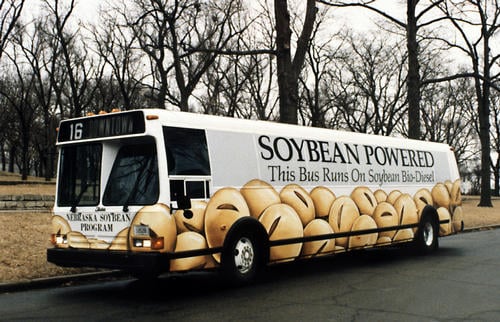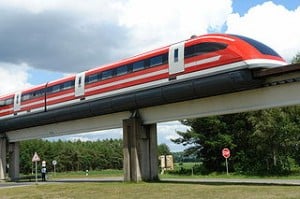I think trying to determine whether separate thoroughfares – be these primary or secondary vehicle-traveled ways – for buses and trucks apart from that for automobiles would make for an excellent case study. And, one of the locations where an old railroad corridor could serve as a proving ground is in Santa Cruz County, California, connecting the cities of Santa Cruz and Watsonville situated along the state’s scenic north-central coast.

So, why take the time to study this at all?
Well, for starters, there are certain times of the week where two-lane State Route 1 (alternatively known as the Pacific Coast Highway or PCH) experiences extremely heavy traffic which affects flow. In other words, vehicle speed slows. The highway there is used by vehicles of every description, or so it would seem. Even bicyclists are allowed to use major portions of this north-central coastal cities connector.
Another reason, the county is in the midst of trying to decide what to do with this old railway and right-of-way, anyway. Could it serve as a so-called “relief valve” in that it could serve to remove at least some of that PCH traffic in this area? Possibly, depending upon what remedy is chosen.
A common solution to alleviating highway congestion and gridlock has been to just add more capacity to the highway by adding more lanes. But due to what is known as “induced demand,” it seems to be the case in more instances than not, that the additional lanes that were put in place to improve traffic flows, after a time, they themselves become traffic constrained. So this essentially puts the very highway in the same position that it was in prior to the extra pavement going in, making for what could be called a zero-sum solution.
In the case of the old railway corridor train-tying together Santa Cruz and Watsonville, several options are being weighed: a commuter rail, light rail or other rail-based options as well as several non-rail or road-based alternatives like personal rapid transit (PRT) if not a quasi-express right-of-way expressly for buses. The key here is to get a healthy number of travelers to switch over to the PCH alternative so as to improve traffic flows on PCH itself. At least, this is the presumption. If not this, then I, for one, cannot see why there is as much energy and time, if not money, as there is being invested in this matter to try to decide what to do with the old railway and right-of-way. Framed differently, that’s another way of saying “searching for a solution to a problem that doesn’t exist.”
There is also probably a subordinate reason for some wanting to make the railway corridor a viable pathway besides that of just providing relief to PCH in terms of both traffic flow and delay. And, that would be for air relief as well.
Because most highway users in the U.S. drive vehicles that have internal combustion engines which burn gasoline, diesel or other fossil fuel derivative, these vehicles release pollutants into the air, a problem that is made worse when said vehicles encounter stop-and-go or bumper-to-bumper traffic.
So, in this sense, with this consideration in mind, a platform that not only diverts travelers away from this section of highway but at the same time helps improve area air quality by doing so, for many interested persons, their position is that a transit option on the order of emissions-free (zero-emissions) personal rapid transit, for example, is the way to go.

Another argument in favor of the PRT selection, meanwhile, is that where today there exists a railway crossing where railway and roadway intersect at grade (on the same plane or level), the PRT itself could be elevated above so as to allow all would-be intersecting traffic, be it vehicle, bicycle, pedestrian or what-have-you traffic, to pass through unrestricted underneath. This is the way I understand this particular situation, at least.
Whatever alternative is eventually agreed upon, such will obviously have to meet certain pre-established criteria.
In the meantime, what is being undertaken in Santa Cruz County, California in this regard, could be regarded as a case study as a means to determine what can be done in practical, sensible and cost-effective terms in helping if not guiding other locales confronting a similar situation.
With the Santa Cruz application in mind, may the most practical, sensible and cost-effective solution here win.
Related article: “What will it be surface-transport profile-wise, once the pandemic ends? – 2”
– Alan Kandel
Great idea
A small correction: The “two-lane State Route 1” is known as the Cabrillo Highway from San Francisco in the north to around Gaviota (near Santa Barbara) in the south. The Pacific Coast Highway (PCH) is a length of Highway 1 in Southern California (where the trendy abbreviation “PCH” began). Those who are ignorant of (or actively wish to ignore) the history of the highway — usually transplants to the State or people living elsewhere in the world — mistakenly call the entirety of Highway 1 “the PCH.” Some even go so far as to give that name to the whole length of coastal highway from Southern California through Washingon State. From what I have seen, those are mostly marketing designations. But the official (and culturally original) PCH is only in Southern California.
Thank you for providing the PCH/Cabrillo Highway clarification. Now I know.
You’ve hit the nail right on the head in my case: I am, in fact, a transplant myself.
As it relates, back in the ’70s I biked south from Half Moon Bay to San Luis Obispo on one trip and from just north of Santa Monica to Buellton on another along California State Route 1. So, if anyone should have known better, I should have.
Thanks again!
Worth consideration is a “rapid streetcar” service: Low impact battery powered wireless streetcars exist today that are no larger than buses but carry more people and run efficiently on standard gauge rail, like ours.
The TIG/m streetcar has been granted a license to provide a demonstration here once Covid passes.
http://www.santacruzstreetcar.org includes a video, FAQ page, and way to ask questions.
I will be sure to check this out. Thanks for providing.
Separated lanes for self-driving vehicles would be more useful and cost effective.
As far as I’m concerned the self-driving capability beyond that which is available in the relative few vehicles approved for road and/or highway operation currently, is still quite a ways off. I believe we’re talking years off. Assuming that comes about, you’re point is a valid one.